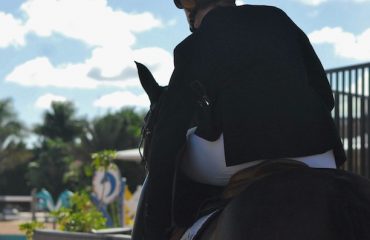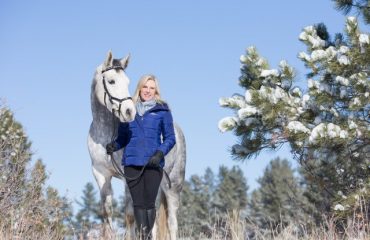How do you handle and jump each type of cross-country obstacle?
Single Fences
Whenever I’m cross-country schooling, I like to start my session with single fences. I try to really practice the art of jumping out of stride and in a rhythm. The design of these fences should be forgiving, with a friendly, sloping face so if you or the horse makes a mistake, your momentum will gently get you over the fence. I like to pick off these fences not at top speed but with the same mentality that you’d compete: trying not to make too many adjustments on the approach, not stop and start, and not make too many changes in your position.
You just want to keep things steady and consistent. It sounds simple, but it’s hard to do well. In my opinion, we should spend a bit of time warming up on the flat and then, the first few fences, warm up at almost the speed of show jumping and as you get warmed up and confident, you can practice going a little faster and faster.
About 65% of a cross-country course is single fences. They’re not technical fences, so we can practice jumping them in a different way than we do show jumping: You want to see a forward distance, land and then accelerate away. Jump one fence at a time to start, then connect four or five at a time so you practice jumping and flowing on. You don’t want the horse to get strong and aggressive as you canter around even at a forward speed: They should stay “polite” and light in the hand.
Having the ability to walk, take a break between fences and think about whether you’re getting too fast before the jump or losing your balance is beneficial. It’s not rocket science, but you want to get really practiced at being as efficient as you can.
As far as rider position, I like to keep my body forward and my seat quite light in the saddle, encouraging a forward rhythm and openness. When you get to more technical questions you have to adjust, but you want to see how easy you can make these fences for your horse.
Seeing a distance comes down to practice: Some are more talented than others at seeing a distance, but the way you get better at it is to get out there and practice approaching from an open stride.
Water Jump
The water jump is schooled the same with even my most experienced horses. First, I’d walk into the water with complete calm and understanding. The moment when they go from dry ground to water is when the horses tend to get quite nervous; they’re trying to figure out if it’s 4 inches deep or 10 feet deep. Part of our training is to teach the horse that we’ll only ask them to go into a comfortable depth. On the surface it could be a deep pond with fish in it — everyone assumes horses know it’s safe, but they need to build that confidence and trust through repeated positive experiences.
Most water jumps have a small step up; the up bank can be misleading as the horse measures the top of the bank to the top of the water and sometimes they don’t calculate that it’s a few inches higher than it actually is, thanks to the depth of the water. They’ll often stumble a bit out of the water and this is a great reminder they need to push a bit more. This is more of a wakeup call than a fright, and part of the learning experience.
Next, I’d trot down the bank; it’s a lot easier going from water to dry ground than into the water.
I’d always be searching for a very small Novice-type fence to jump in. Even with my Advanced horses, the biggest jump I’d school into water is Prelim — if they have a trip or stumble, it could be a long-lasting fright, so we try to keep everything simple and make sure it’s really easy.
I always like lengthening my reins and sitting back; there’s always a chance the horse will stumble a bit and if you’re in a more defensive position, you have a better chance to stick the landing. There are differing opinions, but that’s my preference.
Repetition is the key here — I’d go in and out, in and out. The more often you do it, the more confident they’ll get. I’m lucky we’ve got two water jumps at our farm, but for someone that has to travel, hopefully the jumps will be moved around. Again, never jump too big a jump into water as when things go wrong, you can give them a terrible fright.
Banks
I’d always try to jump an up bank before a down bank. If there’s a smaller version to start with that’s ideal, where you can get the horse confident. Usually I start in trot because the horse can have a better understanding going slower, and in the two-beat trot it’s hard for the horse to rush at the end. It also encourages the horse to take off closer to the fence, which is ideal when you come in at a canter. I love grabbing hold of a bit of mane; sometimes it’s hard to judge the takeoff and this helps the horse take you with him. It’s not fun to get left behind up a bank!
In the canter I’d go for an uphill, light balance similar to a show-jumping canter and look for that close distance. What you don’t want to do is go for a long, fast distance because that opens the opportunity for the horse to chip in or leave a leg. If you get nice and close, the horse should have a comfortable jump up.
Jumping down a bank, you don’t want the horse to jump up high and balloon off the bank — you want them to get to the edge of the bank and sort of shuffle off. Coming in at a trot will encourage this. There are two variations on rider position: One, slip the reins, sit back, keep your bum in the saddle and sit right behind the motion. The key is to let the horse take a couple of strides and then hold your position on landing so you don’t get popped off.
The second position is a little bit of a two-point position, going with the motion and staying with the horse. The horse will land in a better balance if you sit this way, but if the horse stumbles you’re in a slightly vulnerable position. A lot of the legendary horsemen out there feel strongly about one position or the other. I think it’s best to practice both and then use whichever one makes you more comfortable, and adjust according to the footing or what kind of jump is coming up after the drop.
If the horse hesitates, the smaller the drop the better. I often find if you go up the drop first, that’s key. Repetition over small fences will build confidence. I wouldn’t take a green horse and try to manhandle him off a big drop; I think that’ll give him a fright and make things difficult in the future. Cross-country jumping is all about confidence: It’s not “the toughest or bravest man wins.” It’s about building your horse’s confidence so they learn to enjoy it. They’ll do anything for you once they have understanding and confidence. It’s also not a sport where the faster you go, the better. A bit of strong riding on course in a competition has its place, but that’s sort of a last resort: We want horses that are calm, cool and confident.
Photo by Jan Westmark













